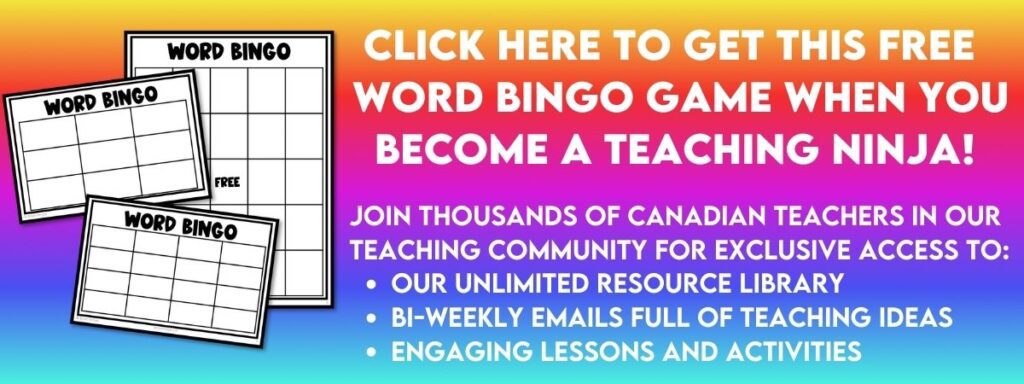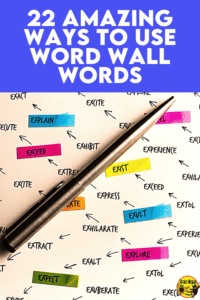
What are word wall words?
A word wall is an organized display of a collection of words that are usually left posted on a wall or bulletin board for a long period of time. The words are typically high-frequency words. Posted word wall words can provide a visual reference for students throughout a unit of study, a term, or a year. Teachers and students use these words continuously.
But are you guilty of hanging up your words and then forgetting about them? Come learn how we make our word wall more interactive.
Why use word walls?
Even though word walls tend to be seen in the classes of younger students, they can be used effectively in upper elementary grades (and higher). They are less for sight words and more for learning to use the words in context or applying the words to their learning through the subject areas.
Using word wall words gives quick access to a set of words for students to use in multiple ways. Students use the word wall words as a reference point. They can help students see patterns as well as similarities and differences. Use the words to reinforce vocabulary. Display words you want students to know. Expand student vocabulary. Word wall words are a useful tool in the classroom (as long as they are used).
As students gain more independence, they can use the words to complete their work or to facilitate their thinking. English Language Learners would greatly benefit from word wall words too.
Posting word wall words also helps level the playing field. Students who might struggle have an easy, low-risk way of accessing vocabulary words. Students can use the words to help them form questions and give responses. Your English Language Learners will benefit from being surrounded by English words.
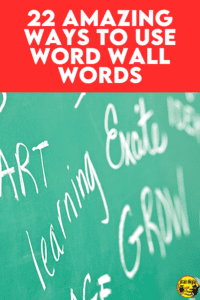
What are the different types of word walls?
There are many kinds of word wall words. Each serves a different purpose. This may vary between age groups. Lower grades might have word wall words that are high-frequency words. For upper grades, word wall words can be used for spelling words, parts of speech words, frequently misspelled words, spelling patterns, prefixes, and suffixes.
Another great way to use word wall words is to post content-area words or unit words. Adding definitions and diagrams as you go can increase the engagement of students with the word wall.
Print the words in large print so that students can refer to them easily up on the wall.
Where to put a word wall?
Pick a visible spot that all students can see. Posting them on the wall is the most common use. But if you have the space, make them interactive to allow you and the students to remove, use and replace the words on the word wall.
Use a tri-fold display board for subject-specific words for words designed to be part of one unit. This makes the word wall more flexible. It also allows for the display to be moved around the room to be used at centers. Unless you have giant walls, there will not be enough room to put up every single word all year.
We tend to switch out words in science and social studies for our units, but math words and commonly misspelled words stay up all year.
Don’t have room for a word wall? A personal dictionary is a much smaller way to use word walls. You can grab this personal word wall that uses Canadian spellings in our store. We also have a version with American spellings.
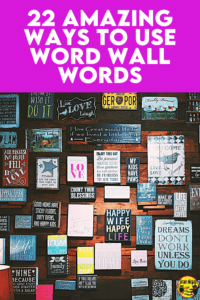
When to use word walls?
When using the word wall words while teaching, it helps remind students of the key vocabulary words or concepts. You can choose to hang up the words prior to a lesson, during the lesson or have your students help by hanging up the words after the lesson.
These words can be used as a way to connect old learning with new learning. Referring back to the words while building on new learning helps students make connections.
Use the words often. Refer to them as much as possible. The more you model how to use them the more students will use them independently.
How do you decide which word wall words to use?
Use the words your students are commonly misusing or misspelling. Look at the writing your students do and choose words that you repeatedly see being spelled or used wrong.
Think about the words students constantly ask you to spell.
Make a list of keywords for math, science, and social studies that students will need to read and write on a regular basis.
Look at guided reading vocabulary lists for your grade level. There are usually a series of words for each grade level that are expected to be spelled correctly by that age.
22 Ways to Use Word Wall Words
This is a giant list of ways we’ve used word wall words in our classroom. As you teach students these games, keep a list nearby. Students can work on these activities with a partner during your guided reading time while you are attending to other groups. To read more ways to keep students busy during guided reading check out this post: Help! What Do the Other Kids Do During Guided Reading?
Word Wall Bingo
Students create their own bingo card with words from the word wall. Then call out definitions, word patterns, or the words themselves. Students mark off the word on their bingo card if they have the word.
We have a set of easy-to-use blank bingo cards that are perfect for Word Bingo. We’ll send them to you for free when you sign up for our email list. They are also available in the Resource Library.
Guess the Word
Give clues to the word and have students guess which word wall word you have secretly picked. Or have them ask yes/no questions about the word and have students try to guess the word. Clues could include the letters, letter patterns, rhyming words, meanings, number of letters or more challenging clues like “this word has two more vowels than this other word.”
Scrambled Word
Scramble the letters of a word and have students unscramble the words. Have students do the scrambling for each other.
Word Relationships
Students pick two words and ask other students to guess the relationship between the words. This is a great higher-order thinking game. Guaranteed, students will find relationships that you never would have thought of, especially students who think outside the box. This could be challenging for some students, so pair them up as needed. You may discover student misconceptions about words through this game.
Word Family Chain
Start with one word from the wall and have students come up with a new word by changing just one letter in the word. For example, if you start with the word ‘cat,’ the next word in the chain could be ‘cap’ by changing the last letter. The following word could be ‘tap’ by changing the first letter and so on. Work as a class or have students work in pairs. This is even more challenging with longer words.
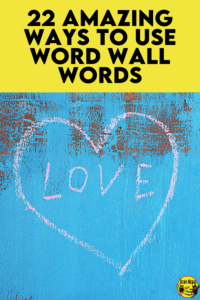
Fill in the Blank
Write sentences with missing words from your word wall words. Students complete the sentences using the words posted. Students could build their own fill in the blank sentences as well. Challenge students to write different kinds of sentences, the longest sentences possible.
Sort the Words
There are all kinds of ways word wall words can be sorted into different categories. Sort by alphabetical order, parts of speech, spelling patterns, or word family. For an extra challenge, have students come up with their own categories and then explain the sorting rule.
Compare and Contrast
Pick two words to compare and contrast. Maybe you have the words ache and break on your wall? A similarity might be that they rhyme. A difference might be that even though they make the same sound the sound /ake/ is spelled two different ways.
Make connections between terms, words, or concepts. This could be explicit or you can have students come up with the connections in their own words. Connections could be word parts, letters, meanings, or even the number of letters.
Picture It
Have students illustrate the word wall words. This makes them personal. Draw diagrams or have students research and print images from the Internet.
Word History
Pick one word and study its origin and its history. This is called etymology. Studying the history of words can give a lot of information about words. It can help students make connections between words.
Affix That
Pick a word to study its root, prefixes, and suffixes. Students can expand their vocabulary by understanding how prefixes and suffixes work (their meaning and how they change the meaning of the words they are added to).
You can also take a word and see how prefixes and suffixes can be added to it.
Same, Opposite
Study the synonyms and antonyms of the words. This is a great activity when you are trying to expand student vocabulary. It is also a great way to improve student writing.
Advertise That
Ask students to create ads using a word from the wall. Maybe it’s an ad to ‘sell’ the word or it’s an ad for something that uses that word. There are many options and this gives students a chance to be creative.
Word Puzzles
Create a rebus for a word. A rebus is a simple picture that is used in place of a word in a piece of text.
Dramatize
Use the words to do drama activities. Students secretly select from the word wall and act it out. Other students try to guess the word. This is a great activity when you need to use up a few minutes before an event like an assembly, recess bell or transition to another place in the school.
Spelling
We don’t believe in weekly spelling tests (that’s a whole other blog post) but other spelling or word work activities can be done. The purpose of a word wall is to provide students with a visual of how words are spelled, so use your wall as a reference to spell words correctly throughout all the subject areas.
If you are doing any kind of a spelling list, add the words from your spelling lists to your word wall.
Handwriting and Cursive Writing Practice
Practice these skills without needing to do a whole lot of work to make this happen. Use your word wall words to practice cursive writing (which will also reinforce how they are spelled). Just pick a few words and write them out. Students can write them three to five times while practicing their penmanship.
Morning Message
If morning messages are your jam, then use your word wall words in them. Seeing the words in context helps solidify the understanding of the words. Morning messages are greetings or simple bell activities that are done first thing in the morning.
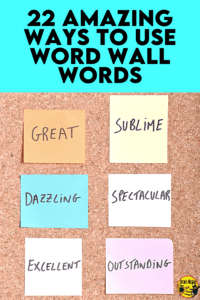
Riddles
Have some fun and create riddles to guess words. It works your students’ brains to get them thinking about the words and different ways they could be used in puns, riddles or even jokes.
Poetry
Students can write poems using the words from the wall or write a poem about one of the words. Poetry is a great way to get kids writing because it feels short and sweet.
Idioms
Find examples of idioms that use the word wall words. If your students don’t know their idioms, try out this fun Idioms Activity.
This is How I Feel
Use a word wall for social-emotional language. Help give students the words to express how they are feeling. We use our Managing Feelings Word Wall to introduce a variety of feelings and emotion words.
Are you looking for other Language Arts ideas?
- Give Your Reading Instruction an Easy Twist
- How to Teach Reading With Book Clubs
- How to Use Google Meet to Run a Book Club
- Research Skills: How to Teach Text Features
- How to Celebrate Poem in Your Pocket Day
- Practical Strategies for Reluctant Readers
- Help! I Don’t Know How to Do Guided Reading
- Help! What Do the Other Kids Do During Guided Reading?
- Preparing For Guided Reading Groups
- How to Run Your Guided Reading Instruction
- Add Great Content to Your Literacy Lessons
- How to Set Up Your Reading Comprehension Schedule
- Challenge Your Students with Writing Activities
- How to Include Different Types of Writing In Your Classroom
What other ways do you use word wall words? Let us know because we would love to hear your ideas. Leave us a comment.

